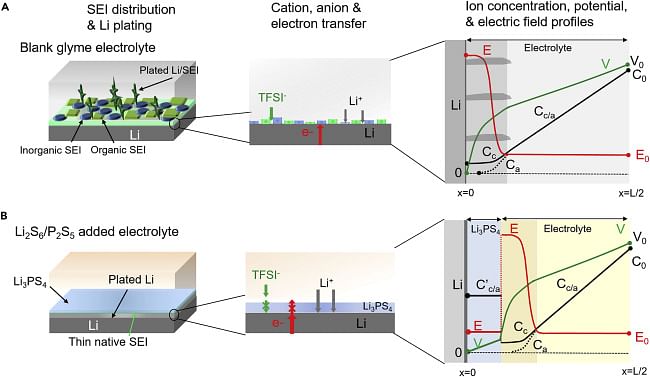New research claim breakthrough; to allow triple electric car range
The breakthrough claims to have the potential to ‘dramatically increase battery storage capacity’ which could triple the range of electric vehicles.
The race for exploiting the potential of lithium-ion battery which powers the electric vehicle is accelerating on full-pedal. In just a fortnight, of a announcement made by Samsung Advanced Institute of Technology (SAIT), where they claimed to have developed a new material that allows 45 percent increased battery capacity and five times faster charging speed, researchers from the University of Waterloo released a new paper claiming a breakthrough in the technology that will allow triple electric car range.
According to the researchers, the latest battery breakthrough involves the use of negative electrodes made of lithium metal, which has the potential to ‘dramatically increase battery storage capacity’ that could triple the range of electric vehicles.

(A and B) In the glyme electrolyte (A), the non-uniform SEI leads to locally enhanced current well above the limiting J*, and anion depletion gives rise to large electric field that drives dendrite formation. In contrast, with the Li2S6/P2S5 additive (B), the in vivo formed Li3PS4layer generates a uniform ion-conducting layer, which blocks the migration of TFSI− near Li surface and thus intrinsically prevents ion depletion and large electric field. The derivation of the profiles is based on Chazalviel's mode.
According to the paper, the current issue with Li-metal batteries was its quick degradation due to dendrites that formed in the cells. The research was led by Quanquan Pang, while he was a PhD candidate at Waterloo (now a post-doctoral fellow at MIT). It claimed to have solve the issue of degradation by ‘adding a chemical compound made of phosphorus and sulfur elements to the electrolyte liquid that carries electrical charge within batteries.’
It said that the compound reacted with the lithium metal electrode in an already assembled battery to ‘spontaneously coat it with an extremely thin protective layer.’ This enabled them to use lithium metal electrodes in battery cells, while taking advantage of its greater storage capacity without compromising on safety and avoiding faster degradation.
Pang said, “This will mean cheap, safe, long-lasting batteries that give people much more range in their electric vehicles.” The research paper claims to have completed ‘over 400 cycles at 5-C rate’ in prototype cells, which helped them achieve a ‘close to 100 percent coulombic efficiency.’
The research paper can be found at the journal Joule .
RELATED ARTICLES
Horse Powertrain reveals hybrid conversion for electric cars
Engine-making joint venture of Geely and the Renault Group announces new hybrid powertrain that fits into the same space...
Aisin to produce hybrid motor for Mitsubishi in Thailand
The hybrid drive motor and gearbox, will be produced at Aisin Powertrain (Thailand) Co for use in the Mitsubishi XForce ...
GM reports strong Q1 sales in China, demand for EVs and hybrids surges 53%
General Motors and its joint ventures in China have sold more than 442,000 units between January and March 2025.






 By Autocar Professional Bureau
By Autocar Professional Bureau
 26 Jun 2011
26 Jun 2011
 2667 Views
2667 Views









